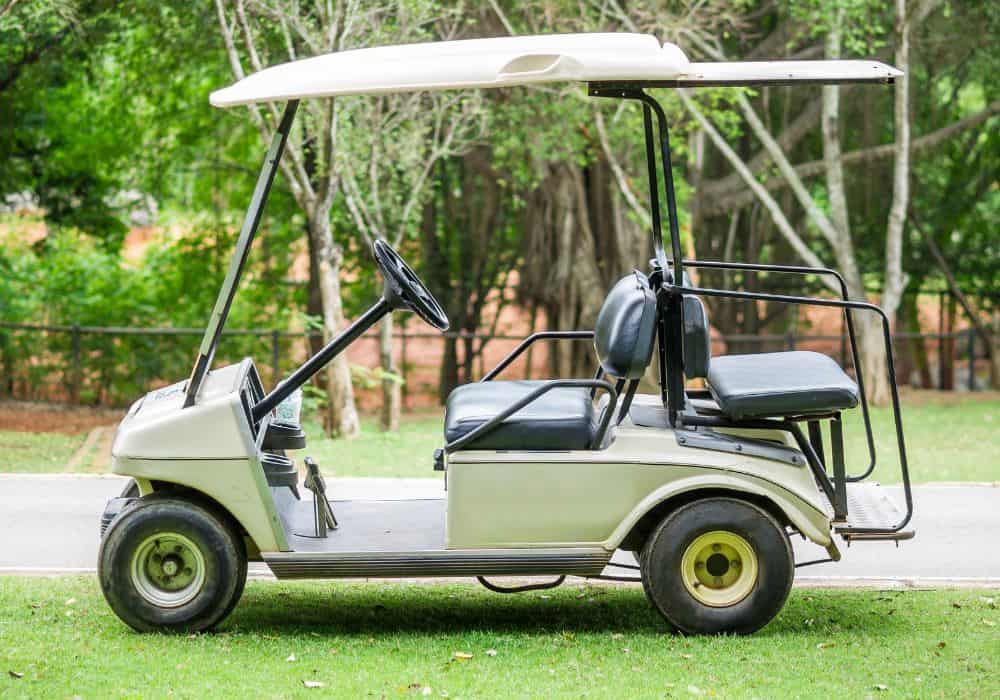Unfortunately, golf cart batteries do not last forever. While their design allows you to maintain them and extends the lifespan beyond that of most vehicle batteries, a cart battery rarely lasts any longer than 10 years.
This can easily be diminished to a few months with improper care, but those with meticulous maintenance schedules might be lucky enough to exceed a decade of use.
In this article, we explain why this is the standard expected life of a golf cart battery, signs your battery is on its way out, and factors that influence their lifespan. We also explain how you can maximize battery life through proper care and maintenance.
Table of Contents
Expected Battery Life of Golf Cart Batteries
The expected battery life of most golf cart batteries sits at 10 years. This assumes proper maintenance and excludes extenuating conditions such as high-temperature storage or improper charge cycles.
Some cheap batteries have a shorter lifespan, but they’re usually up front about this. They may only last a few years, but they allow you to replace your battery as needed despite a tight budget.
Note that this expected battery life is based on the manufacturing date of the battery. A battery that sat on the shelves for a year should only be expected to last another ten years after you purchase it, so make sure you check the age of your battery.
How to Check Golf Cart Battery Age

Electric golf car batteries have some sort of stamp either on the battery terminal, the sticker, or the battery case to tell you the month and year of manufacturing. This helps you remember how old your battery is, age of the batteries on the shelf, and verify used battery’s condition.
This date is usually noted in letter-number format, with the letter corresponding to the month and the number for the last digit of the year. A battery stamped with “B-9” was manufactured in February 2019.
While there is a chance that the last digit may indicate the previous decade, the short lifespan of a golf cart battery makes it unlikely.
Golf Cart Battery Warranties
Warranties for electric golf cart warranties do not match this life expectancy. Instead, they usually cover a full replacement for a few years (with proper use conditions) and then feed off into an extended limited warranty.
The limited warranty has more fine print than a full coverage warranty, dictating replacement based on a number of factors, including:
- Hours of use
- Charge cycles
- Battery damage and care
Most limited warranties feed into residual payouts based on time and condition, and they only cover a few years beyond the full coverage warranty.
Signs You Need a New Battery
Signs that your battery is going out may pop up at any time, even if it isn’t near the maximum life expectancy.
Most battery issues lead to performance problems. A bad golf cart battery struggles to provide enough power to go up steep hills, and it might take longer to charge.
If you ignore the issue, the battery can break down and leave you stranded in the middle of a round of golf. It can also cause other batteries to deteriorate faster, even if they were otherwise fine.
In the worst situations, a failing battery affects electrical components further in your system, damaging your golf cart and leading to more expensive repairs.
Thanks to video guides like the one above, you can easily replace your battery on your own.
How to Test Golf Cart Batteries for a Definitive Answer
You can check the voltage of a golf cart battery with a voltmeter to determine whether it’s charging completely, but we suggest a comprehensive test with a battery discharge tester.
Don’t bother buying one of these units to keep in your garage. Instead, find a golf cart dealer near you that allows you to test batteries with their industrial unit.
They will charge your battery completely, then hook it up to the machine. It then takes a consistent energy draw to determine your battery’s discharge rate. This is the most effective way to gauge the health of your battery.
Factors that Affect Golf Cart Battery Life
The following factors can make or break your golf cart’s lifespan, so it’s important to pay attention to these details.
1. Battery Brand and Quality
Like many things, you get what you pay for when it comes to golf cart batteries. A quality battery may cost twice as much but pays off with reliability and double the lifespan.
Budget options usually work fine for your battery pack, especially if you find yourself in a position where money is tight, but they last a fraction of the time and may be more frustrating to work with.
2. Charging Habits (Overcharging)
Deep cycle batteries are sensitive to both undercharging and overcharging. The latter is common when you use a manual charger and forget to disconnect it when charging is complete, cooking the internal components of your cart battery.
One instance isn’t Earth-shattering, but regularly overcharging your battery will burn through its potential. Modern automatic chargers switch off when the battery reaches a full charge, and they’re a worthwhile investment for hands-off charging.
If you cannot replace the battery, make sure you set an alarm to remind you to check on your batteries.
3. Maintenance Schedule
Following the suggested maintenance schedule for your golf cart battery is the best way to prolong its life.
- To start, check the water at least once a month (most recommend checking the water level weekly) after the battery charges completely and cools down. Remove the plastic caps for the cells and top off the reservoirs as needed with distilled water.
- Low fluid levels, high fluid levels, or using the wrong liquid (such as tap water) can harm your battery and shave years off its life.
- Clean batteries also last longer than dirty ones. Make sure you clear any corrosion buildup around your terminals to prevent significant damage and ensure complete connections.
- Recharge your batteries every time you use them, even if you just drove down to the mailbox. The regular discharge and charge cycle promotes a longer lifespan and keeps your battery healthy.
- Remember that golf carts have both on-board and off-board chargers, and they have different procedures to follow for optimal battery health.
- The off-board charger stays at home, usually in your garage, and is a convenient charging collusion. This is where you plug in your batteries separate from your golf cart after every use for a full cycle.
- The on-board charger plugs into any regular outlet with an extension cord, but you should be picky with your cord choices. Choose a cord as short as possible to limit resistance and heat buildup.
4. Usage
A cart battery may not last as long if it’s put under more stress, such as intense activity or a greater volume of use. For example, fleet carts run through about 2 to 3 rounds of golf in a day and last an average of 4 to 6 years.
A personal golf cart that follows the same maintenance schedule can reach 6 to 10 years of life because it only visits the golf course for three rounds in a week.
5. Additional Golf Cart Features and Accessories
The more bells and whistles on your golf cart, the more stress it puts on the battery. Examples include:
- Headlights
- Horns
- Windshield wipers
- Modifications for street-legalization
The differences aren’t enough to merit a downgrade in features, but you should understand the implications. These features have a more obvious effect on the battery power than the eventual lifespan of the battery, although you may not get as much life from a single charge.

6. Battery Storage
Storing where temperatures are too high or too low can kill your battery without warning. It’s important to keep your golf cart battery in a cool, dry location and check the voltage every six weeks or sooner when storing for an extended period.
Keep in mind that high temperatures cause the battery to self-discharge. You may not think this is an issue when storing for the winter, but it’s more likely to happen if you place them too close to a heat source.
Once your battery charge drops below 70 percent, top it off to keep up with the discharge/recharge cycle. Inspect the battery chassis for any signs of wear or acid leaks, and address any issues as they arise.
Conclusion
Taking good care of your golf cart battery is the best way to ensure it lasts a full lifetime, whether that’s the expected ten years for quality batteries or less for budget options.
Some details, such as frequency of use, cannot be avoided, but understanding how they affect battery life helps you prepare for the future.
How long do your golf cart batteries usually last, and how do you keep them in top shape? Comment with any tips, tricks, or observations!
